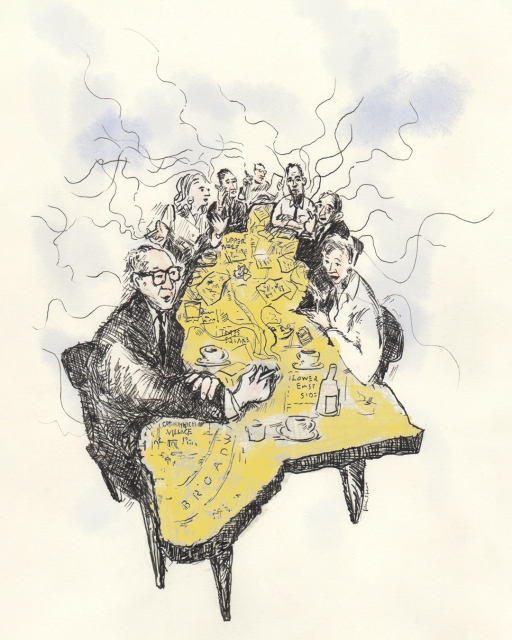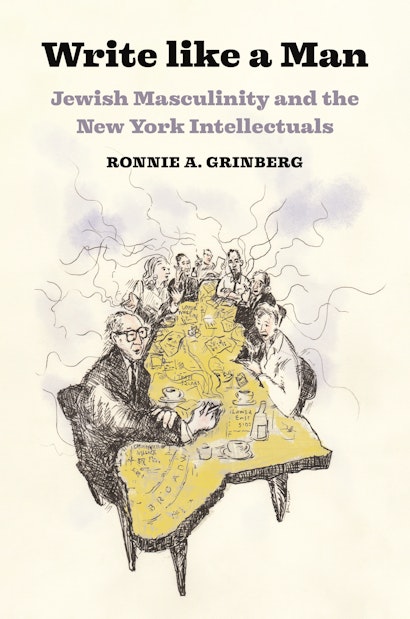When we think of Jewish masculinity in the United States, our imagination likely conjures up the quintessential nebbish: the neurotic, bookish, geeky intellectual type: think Woody Allen or, more recently, Seth Rogen or even Timothée Chalalemet. That any sort of Jewish intellectual type could have played traditional “masculinizing” role in American life may be hard to fathom.
Yet that is exactly what the Jewish New York intellectuals did in the middle of the twentieth century. This celebrated group of mostly male and Jewish writers, which included figures like Lionel Trilling, Alfred Kazin, Irving Howe, Norman Mailer, Daniel Bell, Irving Kristol, and Norman Podhoretz—forged a uniquely American vision of Jewish masculinity that at its core prized verbal combativeness, polemical aggression, and an unflinching style of argumentation. This combative, masculinized style and politicized work ultimately came to define American intellectual life broadly in the second half of the twentieth century. Hollywood even took note. In his 1977 academy-award winning film Annie Hall, Woody Allen satirized the fame of the New York intellectuals. The film’s protagonist, Alvy Singer, played by Allen, joked that he heard the magazines “Commentary and Dissent had merged to form ‘Dysentery.’” Allen’s quip spoke to the prominence of the New York intellectuals and to the many magazines they founded in the postwar years, but also “their ceaseless internecine quarrels,” as Irving Howe once described it—their intensity and pugilism when it came to argumentation on the written page.
To the nineteenth century, writing was in many ways considered feminine—though never simplistically so. Women were the main audience of literature, as Jane Austen, the Brontës, Elizabeth Barrett Browning, Harriet Beecher Stowe, Emily Dickinson, George Eliot, and Edith Wharton were recognized as masters of the verse and prose—though George Eliot was well advised to change her name from Mary Anne Evans, and to have an affair with an influential man. Moreover, male writers obviously had great authority and made unimpeachable contributions to what women read. That said, women also took over the teaching profession, and shaped everybody’s sense of literature, and, to an extent, controlled their very access to it. Half a century ago the historian Ann Douglas argued that writers, like ministers, painters, and professional actors, were considered ‘sissies’ in the golden age of the novel. If not always implicitly homosexual, they were sexual outlaws, like the pioneering New Yorker Walt Whitman. Roosevelt tried to reclaim writing—and high culture in general—as masculine in the years of the twentieth century. But, according to Douglas, nobody succeeded in remasculinizing literary culture until Hemingway’s generation. That “lost” generation’s urban culture was shaped both by African American migrants moving north from the rural south as part of the Great Migration as well as immigrants from Eastern and Southern Europe, who landed on American shores in large numbers beginning in the 1870s and 1880s. The New York intellectuals’ parents were part of that migration. That their sons—who had no yichus, a Yiddish word meaning “eminent pedigree”—contributed to this process of masculinization is significant, especially given stereotypes that had long cast Jews as unmanly.
The New York intellectual’s understanding of secular Jewish masculinity first took root in immigrant enclaves in New York City in the 1920s, 30s, and early 40s. These sons of immigrants sought to forge their own vision of masculinity that contrasted with their working-class, immigrant-born fathers, some of whom were unlearned and who struggled to earn a living—they were, in their own son’s eyes, emasculated. Their sons yearned to be American men. But these were also years when antisemitism and American nativist tendencies climaxed. In reaction to mass immigration and the breakdown of racial barriers, Anglo-American ideals of masculinity became more extreme and discriminatory, embracing traits like physical strength, honor, individualism, and athleticism that non-white non-Protestants allegedly lacked. Excluded from mainstream norms of manhood, Jewish masculinity evolved alongside mainstream American gender ideals.
What became the New York intellectuals’ secular Jewish masculinity was not assimilationist, however—at least not wholly. In the wider culture in those years, intellectual prowess was often seen as a sign of effeminacy —the scholar was the opposite of the virile male athlete. Yet their vision of masculinity was also not bound by traditional Jewish gender ideals that venerated the Talmudic scholar. Rather, their construction of secular American Jewish masculinity was an amalgam of Jewish and Anglo-American ideals that formed something new: the combative secular intellectual.
In the years following World War II, the New York intellectuals became some of the most renowned critics and writers in the country—bringing their fractious masculinity with them. Over time, style of disputation came to define New York literary life and later, to some extent, academia. These intellectuals founded and edited some of the nation’s most influential magazines, including Partisan Review, Commentary, Dissent, and the New York Review of Books (the latter three are still with us today). By the early 1960s, many had found a home in academia, something possible by the discrediting of antisemitism after World War II, followed by the expansion of higher education catalyzed by the GI Bill and the new subsidies of the Cold War. Opportunities in universities that just fifteen years earlier had discriminated against Jews opened up to these figures, even as many lacked doctorate degrees, including in traditionally genteel fields like English. The gentility of American letters would never be the same.
The group’s vision of Jewish masculinity was also not just the domain of men. The few women considered New York intellectuals—Mary McCarthy, Hannah Arendt, Diana Trilling, and Susan Sontag, among them—also outwardly embodied Jewish masculinity. They had to be taken seriously. That is, they wrote like men. Though they would not have put it this way. They thought of themselves as just writers. They undoubtedly encountered what feminists called sexism. For example, when deemed too combative and opinionated they were denigrated as difficult and bitchy. Yet few sympathized with feminists who in the 1970s challenged a basic axiom of New York intellectual life: the intellectual vocation was by definition masculine.
Yet even at the height of their influence in the 1950s and 60s, these intellectuals clashed over the meaning of Jewish masculinity in a deeply anxious project of self-definition that had profound implications for American Jewry and American politics and intellectual culture. A minority of these intellectuals forged what came to be known as neoconservatism—a rightwards politics centered around virility in foreign affairs, especially in regard to combating the Soviet Union and shoring up Israel which and an embrace of “family values” at home. Yet most New York intellectuals rejected the neoconservative vision of masculinity. Much more enduring was a scholarly Jewish masculinity, which emphasized a purely verbal combativeness, the individual independence of every writer, and an outsider status. This vision of masculinity stills holds sway, even if it has morphed into a nostalgia for a world of erudite and combative disputation that existed before the internet, the fragmentation of the media landscape, and the corporatization of academia.
Ronnie A. Grinberg is assistant professor of history and a core faculty member of the Schusterman Center for Judaic and Israel Studies at the University of Oklahoma.

